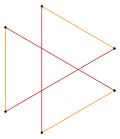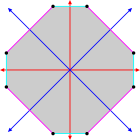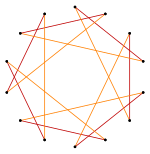Vertex-transitive
Isogonal figure
Polytope or tiling whose vertices are identical
In geometry, a polytope (e.g. a polygon or polyhedron) or a tiling is isogonal or vertex-transitive if all its vertices are equivalent under the symmetries of the figure. This implies that each vertex is surrounded by the same kinds of face in the same or reverse order, and with the same angles between corresponding faces.
Technically, one says that for any two vertices there exists a symmetry of the polytope mapping the first isometrically onto the second. Other ways of saying this are that the group of automorphisms of the polytope acts transitively on its vertices, or that the vertices lie within a single symmetry orbit.
All vertices of a finite n-dimensional isogonal figure exist on an (n−1)-sphere.[1]
The term isogonal has long been used for polyhedra. Vertex-transitive is a synonym borrowed from modern ideas such as symmetry groups and graph theory.
The pseudorhombicuboctahedron – which is not isogonal – demonstrates that simply asserting that "all vertices look the same" is not as restrictive as the definition used here, which involves the group of isometries preserving the polyhedron or tiling.




